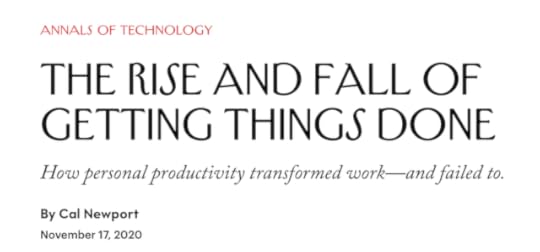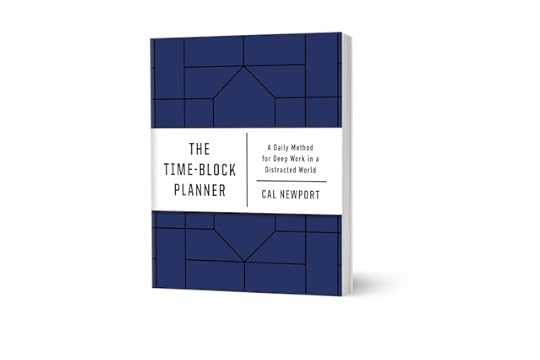Cal Newport's Blog, page 15
December 23, 2020
Andrew Gelman’s 4 pm Rule (a Knowledge Work Reverie)

Andrew Gelman is a professor at Columbia University with a joint appointment in the department of statistics and political science. To say he’s productive is an understatement. He’s written six book, has been cited over 120,000 times, and wields an h-index over 100 (if you’re not sure about this last statistic, ask a professor friend to explain why it’s impressive).
The reason I’m mentioning Gelman is a blog post he published earlier this week. As pointed out by the eagle-eyed reader who sent me the article, in the second paragraph, Gelman casually admits: “I never check my email before 4.”
Rationally, this is exactly what you want from a professor at a major university like Columbia: someone who is perhaps not that responsive to emails, but generates six books and 120,000 citations.
And yet, I can tell you from my own experience, and those of the many professors who send questions to my podcast or emailed me in response to my infamous 2019 article on this topic for the Chronicle of Higher Education, this noteworthy habit of Gelman’s is much more the exception than the rule in academia.
An interesting thought to ponder in the days ahead, during which the Christmas break gives us all a temporary inbox reprieve, is what the world of work would be like if Gelman’s email habit was much less exceptional. What if we were all given the cognitive space needed to pursue our field’s equivalent of 120,000 citations?
I’ll have a lot more to say about this idea in the new year, but for now we can set this up as a pleasant thought experiment; a knowledge work equivalent of dancing sugar plum dreams.
The post Blog first appeared on Cal Newport.December 15, 2020
Unpacking Our Dialectical Relationship with Slack

Earlier this week, I published an essay in the New Yorker about Salesforce’s proposed $28 billion acquisition of Slack. You might assume that my feelings toward this slick-interfaced interruption machine are purely negative, but as I admit: “I do not dislike Slack as much as people assume given that I wrote a book titled Deep Work.”
What interests me more than easy criticism here is the knowledge sector’s dialectical relationship with this tool. People hate it, but they also kind of love it. Slack fragments your attention into minuscule shards, but it also solves issues that make email nearly untenable as a means of organizing work.
As I elaborate in the essay, it’s in this dual reaction that we find the truly important insight. Slack optimized the hyper-communicative, ad hoc, message-driven workflow that email helped make ubiquitous. We love it because it improves this approach to work, but we hate it because this approach doesn’t scale, and therefore ultimately makes us miserable — an observation succinctly captured in the piece’s title: “Slack is the Right Tool for the Wrong Way to Work.”
Anyway, as always, I recommend you read the original article for a fuller take on my thinking.
The post Unpacking Our Dialectical Relationship with Slack first appeared on Cal Newport.
December 11, 2020
From Instagram to Insistent Goats: Another Life After Social Media Case Study

Not long ago, I received a note from a reader named Shandel who wanted to share her experience with social media. She began by noting that she used to “love” these services:
I loved meeting new people and adding them to my friends list. It was a thrill!…I joined a running group and felt super cool to be posting with them and to be tagged in their photos. I was proud of my life and wanted to show it off.”
Then, like many, she began to feel “some unrest.” She worried that she was looking at photos of her kids more than she looked at them in real life, and found herself adjusting her family like models to produce better posts. She started to feel creeped out that “friends” were commenting on these photos even though they’d never actually met.
A breaking point came when the family car got stuck in the snow. Shandel’s instinct was to jump out and begin filming her husband’s efforts to free the tires, as it seemed like a scene that could yield a good haul of likes. “Can you help me!?”, he finally called out in exasperation.
That was the final push: Shandel quit social media. When she wrote me, it had been six months since she made the decision.
“It’s okay. I’m okay. I don’t need to know everything that’s going on. My kids have stopped asking me to put down my phone. I am busier now than I’ve ever been, and I feel more peace in my heart about how I spend my time. I’m currently working full-time from home, raising my kids, raising my goat kids, and gardening.”
Shandel hasn’t abandoned using technology to stay connected, but now does so on her own terms. She still takes pictures of her kids, for example, but instead of posting them to Instagram, she texts them directly to her “actual friends and family.”
The thought of Shandel and her children out in their fields (she sent me a picture of their land: it’s bucolic), feeding the goats, tending the garden, looking toward the horizon and not a screen: made me happy. It’s a nice reminder that although social media can offer diversion from a lot that’s tough in life, it disrupts what’s good as well, and that’s rarely a fair trade.
The post From Instagram to Insistent Goats: Another Life After Social Media Case Study first appeared on Cal Newport.
December 3, 2020
Rethinking the Internet, Again

In October, I wrote a blog post suggesting a framework for the social internet in which users own their own data, including social links, original content, and descriptions of their interests. In my proposal, social networks would compete to offer you the best experience using this common pool of information.
If you don’t like how Instagram is observing your behavior to sell ads, for example, you can now turn to an alternative site that has access to the same pictures and social connections, and can therefore show you the same material, but now with more privacy.
Similarly, if you don’t like Twitter’s content policies, you can turn to any number of alternative applications that have access to the same mini-posts, but can apply their own house rules about what they’ll display or recommend.
A lot of interesting things can happen, in other words, once individual companies can no longer horde your information.
As many readers helpfully pointed out in response to my October post, I was not the first person to have this idea. I was particularly pleased to discover an open source project that attempts to implement something more or less exactly in line with this vision, and that’s headed by someone who knows a thing or two about the world wide web because, well, he invented it.
The project is named Solid and it was started by Sir Tim Berners-Lee, who I used to occasionally see in the elevator at MIT, as his World Wide Web Consortium was headquartered on the floor below my office in the Stata Center.
The core idea of Solid is that people house their digital data in decentralized servers called Pods. You can run your own Pod server, or use a third-party server hosted by a company you trust. The key is that no one organization controls everything. Instead, as with the classic web, all servers can be accessed using a common protocol.
When a web site or application wants to use some of your data, it must now ask you for permission. Using cryptographic tools, you can then grant the requester access to exactly the information you want it to have, and it can use your permission to go gather this data from the relevant Pods. The reverse can also happen: with the right permission, a service can write new things to one of your Pods, such as adding a new social link, or a note from a healthcare provider.
No one company owns your information, and no company can use your information without you knowing. (Indeed, though not specifically referenced by the Solid project, this scheme might even enable Jaron Lanier’s provocative idea of micro-payments in exchange for monetizing your information.)
My short summary here doesn’t do justice to the complex technology underpinning Solid. You can find out more at the official project web site, or in this recent profile from Tech Crunch, which includes helpful case studies.
The larger point I want to emphasize is that we don’t have to settle for the current configuration of our online existence. There’s nothing inevitable about a setup in which a few mega-companies own all of our data and therefore dictate our digital culture. We can do more than boycotts and legislative threats.
Thirty years ago, one man, working as a technology fellow at CERN, had an idea that completely changed the trajectory of the internet. Why couldn’t he — or someone like him — do it again?
#####
My friends at Mouse Books (as featured in Digital Minimalism) are at it again. They just launched a kickstarter for a special edition 3-book holiday collection dedicated to the topic of hell. Seems about right for 2020. If you’re looking for a high quality analog alternative to numbing yourself with your phone, check out this new series.
The post Rethinking the Internet, Again first appeared on Cal Newport.


November 23, 2020
On Technology and Focus: ASMR, VR, and the First Steps Toward Immersive Single Tasking

Around 2010, a curious new term arose in obscure but energetic internet chatrooms: autonomous sensory meridian response. ASMR, as it was soon abbreviated, described a peculiar form of paresthesia experienced as a tingling that starts in the scalp and then moves down the back. It’s often triggered by specific sounds, like soft whispering or a paintbrush scraping canvas. Not surprisingly, those sensitive to ASMR sometimes found Bob Ross reruns to be a reliable source of the effect.
What makes ASMR relevant to our interests here is that it happened to emerge as a topic of discussion just as YouTube emerged as a cultural force. Soon a cottage industry arose of AMSR videos featuring meticulously recorded trigger sounds. One such video opens on a straw stirring seltzer water. A little later it zooms in on a knife scraping dried blush on a make-up tray. It’s been viewed over four and a half million times.
The reason I know about ASMR is that as these “tingle videos” grew in popularity, they spawned a sub-genre called ASMR rooms. The goal in these videos was no longer to trigger the classical tingling response, but instead to invoke a sense of meditative calm and focus.
One such video, for example, is a mostly static shot of Charles Dickens’s victorian-style writing room, with animated flames crackling in the fireplace and a storm raging outside the windows. The scene runs for close to two hours. The only thing that changes is the intensity of the rain:

A popular variety of ASMR room scenes recreates locations from the Harry Potter universe. A couple days ago, a reader pointed me toward one of her favorite examples of this category, a recreation of the magical workshop of Newt Scamander from the Fantastic Beasts movies:

This video features both rain and glowing oil lamps. Extra touches include a glass vessel containing gelatinous, glowing, magical ephemera, and a writing quill that ever so slowly rotates in its inkwell.
The reader told me that she plays the video full screen on her computer while positioning a word processor document in front of it. She listens to the stereo sound in high quality noise cancelling headphones. Though she works out of a “small and noisy urban flat,” the video and sounds help her fall into a state of concentration when she needs to write.
I mention this all because I’m increasingly convinced that something interesting is happening here.
I’ve written before about immersive single tasking, my term for applying technology to induce states of productive and rewarding concentration. It seems like the thriving ASMR room community may currently hold something close to a lead in investigating this possibility.
To me, the next logical step is to figure out how to make this work in a virtual reality context, where the effect of the immersion would be significantly amplified.
The connection between ASMR and virtual reality is at least a half-decade old. And more recently, people have begun porting the ASMR room experience into this new medium as well:

The big problem with the latter trend, however, is that you cannot easily work if you have a large plastic rig covering your eyes. To immerse yourself in a 3d virtual reality recreation of Hogsmeade village on a snowy evening might indeed put you into a state of creative contemplation, but it’s a waste if you can’t also craft any useful artifacts during your moments of techno-induced concentration.
Which brings me to a recent idea: why not integrate automated speech recognition? Perhaps we’re just one small step into the adjacent possible away from actually deriving a strong immersive single tasking benefit here. What if, in other words, we augmented a VR ASMR room with basic speech recognition functionality?
Here’s what I roughly imagine: While you sit in Newt Scamander’s magical workshop, listening to the rain, and examining the haphazard cabinets of curiosities that surround you, a simple click of your VR controller puts you in transcription mode, and your speech automatically appears fleetingly in the scene as lines on the piece of parchment arranged on the desk. When you’re done, your notes are stored safely in a text file.
This would not be an efficient way to polish a chapter of your complex novel, but it could be just what you need to figure out the outline that gets you past a tricky plot point, or, in another context, unstick a new business strategy for your company, or capture an insight that unlocks a recalcitrant proof.
I don’t know whether or not VR AMSR rooms combined with voice recognition technology would actually provide a useful amplification of our latent deep work capabilities, but in a moment in which we’re temporarily stuck in our homes due to a pandemic, eager to produce things that matter, while also constrained by the prosaic limitations of our “small and noisy” surroundings, the time has never been better to start experimenting with the role technology can play in unlocking our cognitive potential.
The post On Technology and Focus: ASMR, VR, and the First Steps Toward Immersive Single Tasking first appeared on Cal Newport.
November 17, 2020
When Did Productivity Become Personal?

My latest article for The New Yorker, published on Tuesday, is titled “The Rise and Fall of Getting Things Done.” It’s not, however, really about David Allen’s productivity system, which longtime readers (and listeners) know I really admire. It’s instead about a deeper question that I hadn’t heard discussed much before: Why do we leave office workers to figure out on their own how to get things done?
With the notable exception of agile software development teams, companies in this sector largely leave decisions about how work is assigned, reviewed, and organized up to individuals. We promulgate clear objectives and construct motivating corporate cultures, but when it comes to actually executing these tasks, we just hook everyone up to an email address or Slack channel and tell them to rock and roll. This has led to a culture of overload and fragmented attention that makes everyone involved miserable.
I don’t want to spoil too much of the piece, but here are two big picture conclusions:
First, our current commitment to autonomy in knowledge work is more arbitrary than we realize. It largely comes from a single, influential management theorist who shaped the evolution of this emerging sector in the mid-twentieth century.
Second, if companies got more involved with the workflows organizing how things actually got done, they could likely increase both their profitability and their employees’ satisfaction.
If you combine this article with my preceding two efforts for The New Yorker, which focused on the topics of remote work and email, respectively, you’ll encounter, in increasing high fidelity, hints of my rapidly-maturing critique of knowledge work, and my optimism for its future.
The post When Did Productivity Become Personal? first appeared on Cal Newport.
November 10, 2020
The Time Blocking Revolution Begins…

I’m excited to announce that my new Time-Block Planner is now available everywhere books are sold online.
I first described my time blocking practice on this blog back in 2013. The idea began to gain traction after I popularized it in my 2016 book, Deep Work. In the years since, it’s been featured in publications such as the New York Times, the New Yorker, Fast Company, Entrepreneur, and Lifehacker.
I often claim time blocking is the secret to my productivity. In my experience, time blockers accomplish roughly twice as much work per week as compared to those who use more reactive methods, and enjoy a much clearer separation between work and non-work time, significantly reducing professional stress and anxiety.
Now for the first time, this system has been captured in a daily planner that makes it easy for anyone to implement these ideas in their own professional life. (To learn more about the system and exactly how the planner works, check out the dedicated site I launched at TimeBlockPlanner.com.)
There are two reasons why I decided to publish my own planner:
The first was convenience. I was tired of hand-formatting blank notebooks. I was also frustrated by paper quality issues and the lack of page marker ribbons that help quickly identify the current page. This planner solves those problems, reducing the friction required to implement daily planning.
The second, and more important, was motivational. It’s one thing to read about a productivity system, but it’s another thing to actually invest in and own an artifact that’s dedicated to implementing that system. I want more people to time block. Buying this planner signals to yourself that you’re a time blocker. It’s also an attractive aesthetic object, with nice paper and detailing. It’s a pleasure to use, especially with a micro-ball liquid ink pen (like this one). These factors might sound small, but they make a big difference when it comes to the challenge of consistently overcoming your mental resistance to stay organized. I think of the planner like a gym membership or Peleton subscription for your time and attention.
To find our more about the planner check out the dedicated site. You can buy the planner at the standard places: Amazon, Barnes & Noble, Powells, Hudson Booksellers, Books-a-Million, etc., and for readers in the UK, it’s available at Amazon UK.
The post The Time Blocking Revolution Begins... first appeared on Cal Newport.
November 4, 2020
Staying Productive on Distracted Days

I don’t normally spend much time reading information online, so I definitely noticed this morning the unusual degree to which I was distracted by breaking election news. This points to an interesting question that I’ve seen discussed in some articles in recent days: what’s the best way to keep getting things done on truly distracting days?
My answer: don’t.
“Productivity” is a slippery term. It’s often used to refer exclusively to the rate at which you produce value for your business or employer. I tend to apply it more broadly to describe the intentional allocation of your time and attention toward things that matter to you and away from diversions that don’t.
A lot of days, this probably involves a solid push on professional activities, as craft is an important part of cultivating a deep life. But not every day. If there are consequential national events transpiring, or you’re dealing with a crisis in your personal life, or you’re not feeling well, a productive day doesn’t necessarily require steady progress through a task list.
The tools I talk about here and on my podcast, like time-block planning, are really powerful, and offer the ability to help you to execute intentional, high impact schedules. This doesn’t, however, eliminate the philosophical question of what exactly a “high impact” schedule means on any given day.
The post Staying Productive on Distracted Days first appeared on Cal Newport.
October 27, 2020
The Stone Carver in an Age of Computer Screens

A reader recently pointed me toward a short video titled “A Continuous Shape.” It profiles Anna Rubincam, a stone carver from South London who works alone out of a utilitarian studio; sliding doors open to a tree-lined patio.
The video follows Rubincam’s efforts over three weeks to produce a stone carving of a young woman’s head. It starts with her taking measurements from a live model. These are then translated into a clay figure, and subsequently engraved, one precise chisel hit after another, into a solid chunk of stone.
The reader who sent me the video titled his message: “Epitome of deep work.” I think he’s on to something.
When you watch Rubincam in action, it’s hard not to feel an intimation of wistfulness. Something about her efforts, in which she stands alone in a minimalist chamber, and hour after hour, with hard-won skill, manifests cognitive abstractions into concrete reality, seems about right.
I think the reason portrayals of physical craft are instinctually compelling is that they present a conception of “work” that closely aligns with our species’ wiring. Part of what separated us from our primate ancestors is our ability to understand the world symbolically; allowing us to make an abstract plan that we then translate into something real. We’re rewarded for this final step with a sense of satisfaction, and punished for its absence with a sense of anxious hollowness.
When contemplating these realities, I can’t help but wonder about the psychic toll of replacing the simplicity of such craft with email, and Zoom, and half-hearted PowerPoint. As I elaborate in Digital Minimalism, a brain forged in the Paleolithic doesn’t fully understand the digital, and is easily overwhelmed by a notion of work defined by constant, unstructured, unceasing electronic pings and dings.
Late in the video, Rubincam looks to camera and explains:
“Once you’ve created something it takes up a physical space in the world and it has a permanence that will hopefully outlast you.”
Here’s to hoping that as the world of work evolves beyond its tactile foundation, we can find a way to extract similar levels of calm human contentment from our daily efforts.
The post The Stone Carver in an Age of Computer Screens first appeared on Cal Newport.
October 20, 2020
A Modest Proposal: Deweaponizing Network Effects

I recently read an important new article titled “Ethics of the Attention Economy: The Problem of Social Media Addiction.” It was written by Vikram Bhargava and Manuel Velasquez, two professors from Santa Clara University, and published earlier this fall in the journal Business Ethics Quarterly.
The article applies a rigorous ethical analysis to purposefully addictive social media platforms. In one section, for example, the authors deploy Martha Nussbaum’s influential capabilities approach to demonstrate that these platforms impair many of the elements required for a dignified human life. Their conclusion is that from a strictly philosophical perspective, service like Facebook, Twitter and Instagram present a “serious moral problem.”
This article is an important academic adjunct to the topics explored in the recent Netflix documentary, The Social Dilemma, and I highly recommend reading it.
I was also, however, intrigued by the concluding section, which explored implications and solutions (and cited Digital Minimalism, which I appreciated). This got me thinking about more radical responses to these present moral problems. I thought it might be fun to share one such, admittedly half-baked, notion here, with advance apologies to the originators of the many similar ideas I’m almost certainly inadvertently overlapping.
What if we got more serious about ceding users ownership over all of their social internet data: both what they’ve posted, but also their links; followers, friends, etc.?
Major legislative responses, such as the European Union’s GDPR, have tried to enforce data ownership, but what I have in mind is both simpler and more extreme.
In my hypothetical scheme, everyone has a cross-platform universal identifier. Every stable social connection on a given service can be imagined as a labelled edge in a social graph that contains a node for every universal identifier.
The key in this scheme is that these edges are owned by the user and must be easily portable to any service.
If, for example, you join a new social internet platform, you should be able, with a click of a button, to import all of your existing social connections from Facebook, Instagram, and Twitter .
Furthermore — and here’s where the proposal gets more fanciful — all such services must provide APIs that make it easy for one to connect to another. The new social internet service you joined, for example, should be able to easily pull in all new Tweets you would have seen in your Twitter timeline, or all photos your Instagram friends have recently posted. (For more on some fledgling attempts at such standards, see my New Yorker piece on the “indie social media” movement.)
As argued in the Business Ethics Quarterly article cited above, one of the major moral issues with existing social media platforms is their ability to trap you in their walled garden, at which point they can, without restraint, wield attention engineering to exploit every last morsel of monetizable attention or data from your distracted husk of a digital body. You can’t leave the walled garden, because everything you care about is locked inside.
But in a scheme like the one proposed here, the locks are opened. If you don’t like Twitter’s addictive interface, or the outrage-inducing Tweets its algorithms push into your timeline, you can jump over to another service that doesn’t try to addict you; perhaps one that charges a modest subscription fee and instead curates a timeline of “deep thoughts” on selected topics, or shows you only the best or most originally twisted comedic memes of the day.
If we want to follow this train of thought to its radical but rational terminus, one might even imagine a publicly-funded technology consortium that stores all social links and all data posted or received on this social graph. In this scenario, every service works with the same public database, forcing them to compete only on the experience and value they bring to their users.
When you’re not trapped in the garden, in other words, you’re not compelled to put up with abuse.
To be fair, I can already think of a dozen issues with this particular, admittedly sketchy proposal. But there’s a broader point lurking underneath that I feel stronger about. Too many of the “solutions” proposed for the moral calamities induced by existing social media platforms focus on directly forcing those platforms to behave better.
But if we owned our social internet destiny, we wouldn’t need Facebook, or Twitter, or Instagram, or (God forbid) Tik Tok, to behave better. We could just turn to an easily accessible, better alternative.
The post A Modest Proposal: Deweaponizing Network Effects first appeared on Cal Newport.
Cal Newport's Blog
- Cal Newport's profile
- 9944 followers



